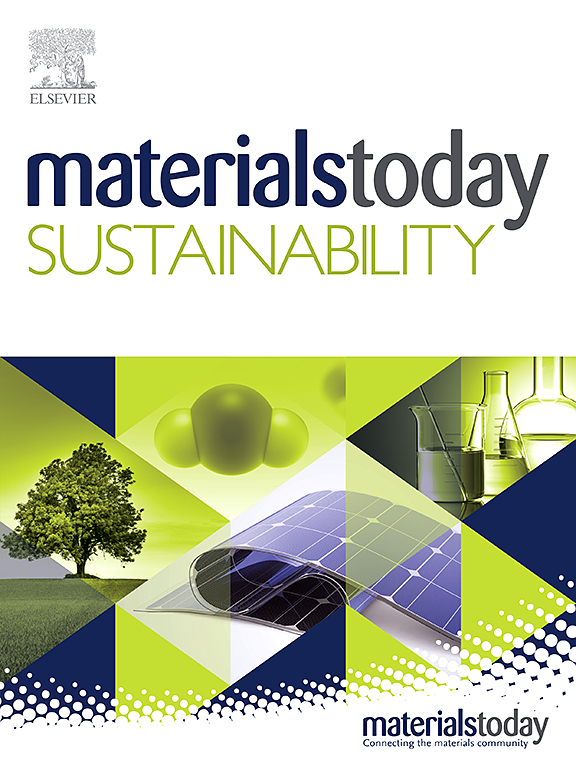初步证明热灭活菌丝体提高生物稳定土材料的耐水性
IF 7.1
3区 材料科学
Q1 GREEN & SUSTAINABLE SCIENCE & TECHNOLOGY
引用次数: 0
摘要
土建材料为建筑提供了一种低碳的选择,但其较差的耐水性限制了建筑行业对其的采用。在土材料中添加生物聚合物可以提高机械强度和抗水性,但也会促进霉菌菌丝体的生长,从而降低室内空气质量。然而,对于绝缘或包装等其他应用,控制特定菌丝体的生长被视为生产天然防水材料的有前途的选择。这些应用需要热灭活来杀死菌丝体并保持空气质量。目前尚不清楚热灭活霉菌菌丝体是否能提高土材料的耐水性。本研究通过促进霉菌在生物稳定土材料上的自然生长,研究热失活后对土材料性能的影响,探索一种新的设计方法。土砂浆是由土壤、水和生物聚合物(土壤质量的2%)混合制成的,质地一致。使用两种土壤和四种生物聚合物的20种配方,在干燥(50°C烘箱)或潮湿(30°C, 98% RH)条件下进行两种不同的21天固化。在经过48小时80℃热处理灭活霉菌后,研究了砂浆的性能。我们发现,潮湿固化持续促进霉菌在生物稳定砂浆上生长,这与未暴露的砂浆相比,具有显着更高的抗水性。具体来说,喷雾后毛细管吸水率和质量损失分别降低28%和64%。这些改进在对收缩率、密度和机械强度影响最小的情况下实现。在紫外显微镜下观察到,疏水霉菌菌丝体填充了土砂浆的孔隙,从而改善了土砂浆的耐水性。总之,本研究表明菌丝体可以显著提高生物稳定土材料的耐水性。本文章由计算机程序翻译,如有差异,请以英文原文为准。

Preliminary evidence that thermally inactivated mycelium improves water resistance of biostabilized earth materials
Earth-building materials offer a low-carbon option for construction, but their poor water resistance limits their adoption by the construction industry. Adding biopolymers to earth materials can improve mechanical strength and water resistance but also promote mold mycelium growth that reduces indoor air quality. However, for other applications such as insulation or packaging, the controlled growth of specific mycelium is seen as a promising option for producing natural waterproof materials. These application require heat-inactivation to kill the mycelium and preserve air quality. It is currently unknown if heat-inactivated mold mycelium could improve the water resistance of earth materials. This study explores a new design by promoting the natural growth of molds on biostabilized earth materials and studying the effect on earth material properties after heat inactivation. Earth mortars were prepared by mixing soil, water, and biopolymers (2 % of soil mass) to a consistent texture. Twenty formulations, using two soils and four biopolymers, were subjected to two different 21-day cures, under dry (oven at 50 °C) or humid (30 °C, 98 % RH) conditions. Mortar properties were investigated after a 48-h 80 °C heat treatment to inactivate mold. We found that the humid cure consistently prompted mold growth on biostabilized mortars, which was associated with significantly higher water resistance compared to unexposed mortars. Specifically, capillary water absorption and mass loss after water spray was reduced by 28 % and 64 % respectively. These improvements were achieved with minimal impact on shrinkage, density, and mechanical strength. The amelioration in water resistance was attributed to the hydrophobic mold mycelium filling the earth mortar pore as observed by UV microscopy. Together, this study demonstrates that mycelium could dramatically improve the water resistance of biostabilized earth materials.
求助全文
通过发布文献求助,成功后即可免费获取论文全文。
去求助
来源期刊

Materials Today Sustainability
Multiple-
CiteScore
5.80
自引率
6.40%
发文量
174
审稿时长
32 days
期刊介绍:
Materials Today Sustainability is a multi-disciplinary journal covering all aspects of sustainability through materials science.
With a rapidly increasing population with growing demands, materials science has emerged as a critical discipline toward protecting of the environment and ensuring the long term survival of future generations.
 求助内容:
求助内容: 应助结果提醒方式:
应助结果提醒方式:


